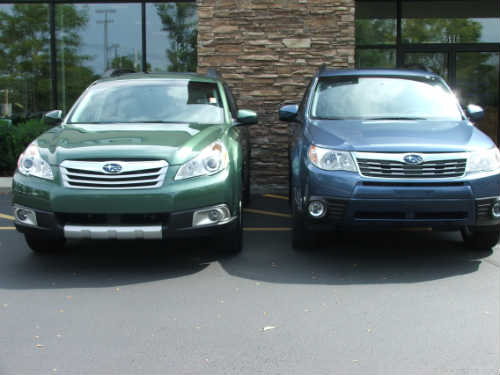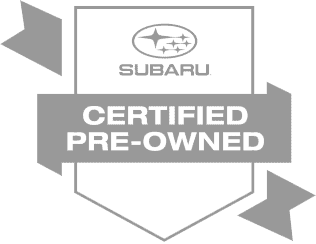
THIS PAGE COMPARES THE 2010-2014 OUTBACK WITH THE 2009-2013 FORESTER. FOR A COMPARISON BETWEEN THE BRAND NEW MODELS, CLICK HERE.

Outback is in green on the left, Forester in blue on the right.

SIMILARITIES:
All 2013 Foresters and Outbacks come standard with all wheel drive, Vehicle Dynamics Control (VDC) to prevent skids, anti-lock brakes, ring shape body structure, six airbags, and many more safety technologies. All Subaru's come standard with Bluetooth hands-free phone and audio connectivity, air conditioning, keyless entry, cd player, power windows, power mirrors, and many other comfort features. All Subaru's purchased at Planet come standard with friendly staff and lots of know-how.
DIFFERENCES:
Dimensions
You can see that the green Outback is two inches shorter, and two inches wider than the blue Forester. Total interior space is about the same for both vehicles (i.e., you could put the same number of ping pong balls in both cars.)


You are looking at the front wheels. The rear axles of both cars are lined up; you can see that the front axle of the green Outback is farther away from its rear axle.

The rear of the blue Forester is more erect than the sloping glass on the green Outback; the Forester is generally better for dogs and boxes in the cargo area.

The rears of both cars are lined up; you can see that the green Outback is about nine inches longer than the blue Forester.

Have big
kids? Go for the Outback and its limousine-like back seat. Have a big
dog? Go for the Forester because the rear door on the Forester is more
erect and there is more height for your pooch to stand up. Cyclists
tend to prefer the Outback, as the extra length makes it easy to throw a
couple bikes in the back without even removing the wheels. If you
sleep in your car, and you're tall, you'll prefer the Outback.
Ride Quality
The Outback has a longer wheelbase (the distance between the axles is five inches longer than the Forester). Think of a stretch limousine...lengthening the distance between the axles provides a smoother ride because the vehicle platform covers more square area and therefore bumps are less noticeable. But don't think that the Forester has a harsh ride; in fact, it rides much better than its small sport utility competitors. It's just that the Outback is even smoother.
Price
Comparably equipped, the Outback is about $2500 more than the Forester. The difference buys you a slightly bigger car, with more standard equipment, and even higher quality materials (such as carpeting and interior surface finishes). To understand all the different Forester models and prices, click here. To understand all the different Outback models and prices, click here.
Ride Height
You sit slightly higher in a Forester, but Subaru engineers designed both vehicles with a "command driving position" (the auto industry term that describes that great feeling of sitting high in a vehicle so you can see what's ahead.) Because of the boxer engine design that Subaru uses, however, the center of mass in the vehicle sits quite low so both vehicles handle quite nimbly and are very unlikely to roll over. Ground clearance is the same, at almost nine inches, so both vehicles elude obstacles that grab mortal vehicles.
Image Perception
Many customers tell us that the Outback looks more like a station wagon and the Forester looks more like a sport utility vehicle and therefore the Forester is more "cool." Planet staff opinion is divided on the matter, which, ultimately, is just one of taste.
Automatic Transmission
The Forester uses a four speed automatic transmission. Beginning with the 2010 model year, the four-cylinder Outback uses a continuously variable transmission (CVT) which has no gears. In very simple terms, it's a fantastically durable steel belt that moves along a cone...the fatter part of the cone for speed, the narrower part for power. This transmission gives the Outback a three mile per gallon advantage in fuel economy, even though it is slightly heavier.
Manual Transmission
The Outback uses a six speed manual transmission; the Forester uses a five speed.
Engines
The standard engine in both vehicles is the same potent 2.5 liter four cylinder boxer engine with 173 horsepower. A 3.6 liter engine is available in the Outback with a five speed automatic transmission, and a turbocharged 2.5 liter engine is available in the Forester with a four speed automatic transmission.
Fuel Economy
With the standard 2.5 liter engine and CVT, the Outback gets 24/30. With the standard 2.5 liter engine and four speed automatic, the Forester gets 21/27.
Go to Inventory
Click here to see our selection of NEW Foresters or NEW Outbacks.
Click here to see our selection of USED Foresters or USED Outbacks.
More Good Stuff!
While you're here, check out all the exclusive Planet content you won't find anywhere else!
Planet Subaru. Your unDealership.



